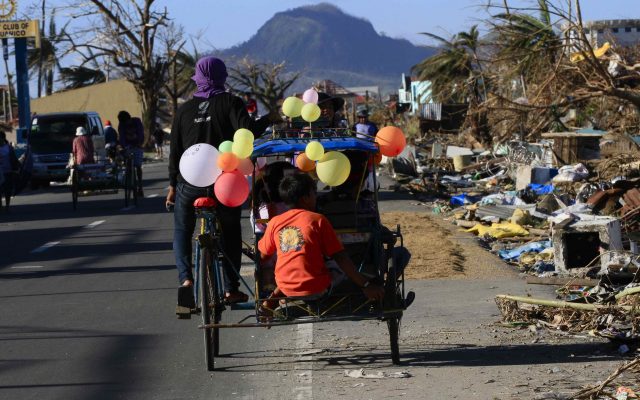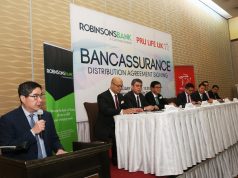
MANILA – At 12 years old, Erica lost her entire family when Supertyphoon Yolanda devastated their home in November 2013.
She misses her father bringing her to school, as well as spending Christmas with her parents and siblings. If she could talk to them again, she would ask them to come back.
Life goes on despite loss and heartache, however. Erica is assured of support for her schooling through the P300,000 she received from her mother’s micro insurance. She can still fulfill her dream of becoming a teacher.
Her experience is similar to that of Emma, a fish vendor also from Leyte, whose house and fishing boat were destroyed. Even if she and her husband had no means to work, they could buy food to eat because she had micro insurance.
Raul, a construction worker from Leyte, was able to rebuild the home he had shared with his wife, who was killed in the typhoon, thanks to the P180,000 he received from her micro insurance.
“Insurance is synonymous with safe, sure, and secure,” said Bernardita Valenzuela, the information officer of Tacloban City.
Already in her 80s, she had walked among piles of bodies in order to seek help in the aftermath of the typhoon.
She was in Manila recently for the launch of a website where online communities – mostly those with a low income – can gather and access micro insurance products through the help of life insurance company Pru Life UK, and sustainable development enterprise Deutsche Gesellschaft fur Internationale Zusammenarbeit (GIZ).
Also attending the launch was Butuan City Mayor Ronnie Lagnada, who was glad to be a beneficiary of a project that would prepare his constituents for the next disaster. He looked forward to being part of a community that was enlightened about the benefits they could reap through microinsurance.
Initially, the site www.empoweringfilipinos.com would offer group insurance products, according to Graham Morris, the chairman of CommLinked, which developed the online community portal.
Interested groups could easily enrol online. Eventually, Morris hoped that micro insurance agents would emerge from the groups, so that interested clients could enrol through them face-to-face.
Dr. Antonis Malagardis, GIZ’s program director for Asia, expected to have 30,000 people from rural, low-income communities in Tacloban City and Butuan City registered in six months. He planned to expand the program throughout the country afterwards.
According to a press release, the communities would also be “provided financial literacy advocacy materials (to) create protection and savings knowledge at the barangay level.”
Health insurance a key concern
Based on a study done by GIZ and covering 300 respondents from the two cities, majority of residents were worried about their health and having the insurance for it. Also weighing on their minds was the possibility of natural calamities and disasters. This was followed by education for their children, and investments for the future, Malagardis said.
There was still a protection gap, according to Pru Life UK president and CEO Antonio De Rosas. This was the insurance protection which every Filipino needed, but did not have, even if they could afford it.
De Rosas cited a 2015 Swiss Re Mortality Protection Gap Asia Pacific study which noted the coverage Filipinos should have, but didn’t, was worth $370 billion.
Another challenge to the insurance industry was the poverty gap. This number had been improving, but a significant portion of the Filipino population remained impoverished, De Rosas said.
He recalled how, in the aftermath of Yolanda, Pru Life UK gave Tacloban residents 180 houses, fishing boats, and pedicabs so they could rebuild their lives. Despite this, a nagging thought still bothered him.
“Here we are, giving, but we cannot right now offer our services, our products,” De Rosas explained. He wanted the insurance company to be instrumental in helping people become fishermen, as the saying went, and feed them for life. And they could only do it by providing the residents microinsurance, which some of the survivors had seen the benefits of.
Due to the sheer number of people that needed to be covered, it was vital to use technology to help with the coverage, he said.
But, he noted, Pru Life UK could not do the job alone. He urged all insurance companies to join them and contribute to nation-building.
IC chief Funa: 2 words, literacy and tech
Insurance Commissioner Dennis Funa, meanwhile, said the ticket to expanding insurance protection could be summed up in two words: literacy and technology.
A new class of apps, software, and digital products had emerged to provide insurance protection in a faster, more convenient, and customized way. As more and more consumers went online, insurers were able to reach a mass that could not previously be reached in a cost-effective way. Technology enhanced customers’ experience, streamlined business processes, and increased agent effectiveness and professionalism.
Through technology, teaching financial literacy was made simple and could be grasped by children and adults alike. With one upload of an informational material, insurers could reach different communities, wherever they were.
Funa said that the Insurance Commission was working hard to keep up with the fast-moving developments in technology.
“I always tell my employees that we cannot be left behind,” he said.
Nevertheless, the old-fashioned way of holding seminars, workshops, and exposure trips worked, too.
The Insurance Commission conducted these beginning in 2010, after it published “The Roadmap to Financial Literacy on Microinsurance.” From there, hundreds of microinsurance advocates in Luzon, Visayas, and Mindanao emerged, and from a mere 3.1 million individuals in 2010, market reach increased to almost 30 million in 2016, Funa said.





